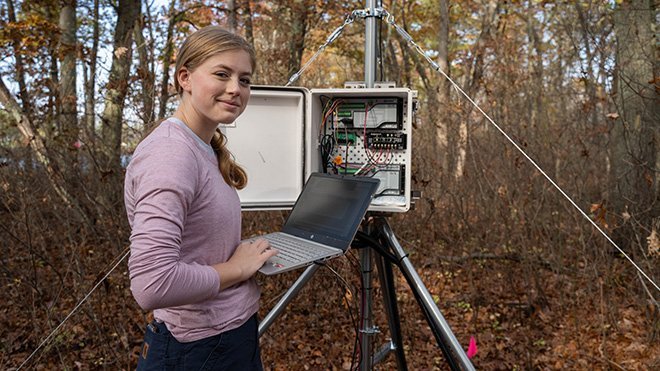Research Rundown: Narragansett Bay Estuary Program Interns Contribute to Blue Economy
Three students’ groundbreaking research projects aim to improve the environment

BRISTOL, R.I. – As the home of the Narragansett Bay Estuary Program, Roger Williams University supports innovative research and advocacy related to the health of our watershed – and now, this partnership is developing real-world environmental justice research for students.
As interns with NBEP, students contribute to protecting and improving the bay and surrounding watersheds, gaining valuable real-world experience and training to become the next generation of environmental leaders. Currently, Environmental Science and Engineering students at Roger Williams are conducting research on a variety of topics, from studying the impacts of climate change on local environments to tackling global issues such as microplastics pollution. Hear from three of these students about their cutting-edge research and why it’s so important to our region and world.
Reducing Soil Erosion with Soy
Who at RWU: Senior Nathan Silveira, a Civil Engineering major and Mathematics minor from Bristol, R.I. (Faculty advisors: Assistant Professors of Engineering Pamela Judge and Ahmet Akosman)
The Big Question: Is it possible to create an environmentally friendly geotextile mesh made with soybeans – instead of conventional plastic – to minimize soil erosion?
In a Nutshell: Geotextile meshes, which are used to prevent soil erosion, are typically made from conventional plastic. Wanting to create an environmentally friendly solution to the current market products, Silveira has been researching ways to create a soil erosion control technology that is 3D printed using soybean-based ink. Using a resin 3D printer located in the Richard L. Bready Applied Learning Laboratories building, Silveira printed geotextile meshes, which he then tested in a wave generator machine designed by Engineering students to study coastal shoreline erosion. He applied different sizes of meshes to a slope in the wave tank to see how much it would prevent the soil from eroding on the slope over a 24-hour period. According to Silveira, “The geotextile meshes that we printed from a soybean-based resin are a more eco-friendly option, so when they degrade into the environment, they don’t add harmful plastics into the soil as the current products do.”
Monitoring Water Quality in Warren
Who at RWU: Sophomore Mandi Greenhalgh, an Environmental Science major and Sustainability Studies minor from Clinton, N.J. (Faculty advisor: Assistant Professor of Environmental Science Joel Singley)
The Big Question: Will the removal of a dam in Warren, R.I., cause any changes in water chemistry with the conversion of freshwater to saltwater, and how will that impact the local environment?
In a Nutshell: Responding to impacts of climate change, the Bristol County Water Authority is removing the lower Kickemuit River dam in Warren to restore the area to a more natural state and improve flood resilience. Greenhalgh’s research involves monitoring the water quality in the dam, reservoir, and groundwater before, during, and after the dam removal. She’s also observing how trees react to the drop in water and if they have a change in sap flow. Using wells and a monitoring station located near the dam, she is able to test both soil moisture and sap flow in trees. The monitoring station consists of a white data logger box attached to a metal stand that contains wires and cables that attach to trees and can be connected to a laptop. The station runs on batteries powered by solar panels attached to the top of the stand. “Because this is a freshwater system that’s connected to a saltwater system, Narragansett Bay Estuary Program wants to work on that connection and make sure the water quality is doing what they would like it to do, and that it’s growing healthily,” she said.
Measuring Microplastics
Who at RWU: Senior Michelle Kryl, an Environmental Engineering major from Westhampton Beach, N.Y. (Faculty advisor: Associate Professor of Engineering Lillian Jeznach)
The Big Question: How many and what types of microplastics are in Narragansett Bay?
In a Nutshell: While microplastics pollution is a growing concern – not just in Rhode Island, but globally – the topic doesn’t receive as much attention as it should, says Kryl. “There isn’t much data on microplastics in the water and in the air in general,” she said. As part of her research, Kryl is assessing the volume and types of microplastics that enter Narragansett Bay. She is part of a long-term microplastics sampling campaign whose goal is to create a database of freshwater and atmospheric microplastics measurements in Rhode Island. After collecting samples from sites across the state, Kryl and other student researchers conduct a visual analysis with a binocular compound microscope to determine if any particles are microplastics. “Now that we’re starting to research more, we’re finding more and more microplastics. That’s why it’s so important to create a database that we can build on,” she said.